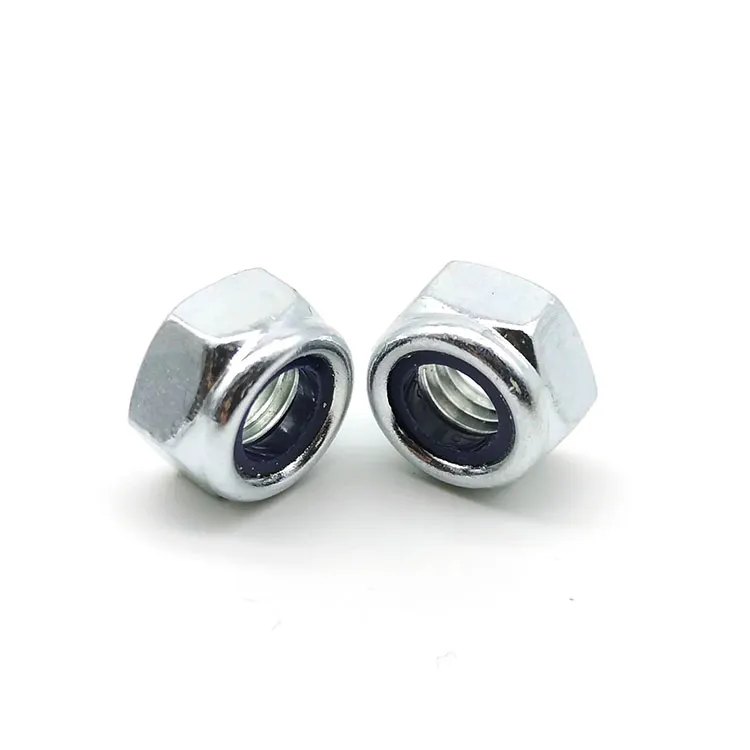What types of self-locking nuts are there?
2024-08-28
The anti-loosening of fasteners refers to the ability of the threaded connection to resist external impact, vibration or variable load, as well as the weakening of the connection performance at high temperatures or large temperature changes after the threaded connection is tightened normally. It is not a matter of manual loosening. Comparison of the displayed torque when turned on.
Self-locking nuts are currently widely used in machinery manufacturing and other industries because they can effectively prevent connections from loosening. With the continuous development of technology, there are more and more types of self-locking nuts.
1) Nylon insert self-locking nut
Nylon insert self-locking nut is a very common self-locking nut and is widely used. Structurally, a nylon ring is embedded into the nut head. Its working principle is that when the non-metallic insert nut is screwed together, the thread of the bolt will naturally squeeze into a spiral on the nylon ring, allowing it to form a tight fit with the bolt thread, and generate friction resistance under the elastic force of nylon. , to achieve the purpose of preventing loosening.
The nylon insert self-locking nut has a simple structure and reliable anti-loosening performance. Tightening will not cause damage to the nut body, and it is also very suitable for applications in places with vibration loads. Can be reused, as the number of uses increases, the anti-loosening properties will weaken.
Screw Jun referred to relevant technical information, and research shows that it is recommended that the nut be used no more than 5 times. Because nylon has weak heat resistance, acid and alkali resistance, it is suitable to be used in the range of -50℃~100℃, and the application environment should avoid acid and alkali.
2) Metal self-locking nut
Metal self-locking nuts are also a commonly used structure, and their structure diagram is shown in the figure below.
The working principle of metal self-locking nuts is to use the deformation of the thread bottom hole or the thread tooth shape deformation to create an interference fit between the threads when mating with the bolt, thereby increasing the friction between the threads to achieve anti-loosening. Purpose. Metal self-locking nuts have good anti-loosening performance and simple structure. Compared with nylon self-locking nuts, their application environment requirements are lower and they are suitable for use in environments with high temperatures and acid and alkali corrosion. Because the deformation ability of metal is worse than that of nylon, even if the size deviation of the part is small, its torque characteristics will vary greatly. Therefore, its dimensional control accuracy requirements are also high, and it is not suitable for applications in places with large vibration loads.
Generally speaking, its anti-loosening performance is better than that of nylon self-locking nuts, and the screwing torque when tightening is also higher. Screw Jun referred to the relevant standards and learned that it is recommended that the number of reuses should not exceed 5 times.
3) Spirau self-locking nut
Spirer self-locking nuts have an innovative self-locking internal thread tooth structure with a unique 30° wedge-shaped bevel at the root of the thread. Due to the change in the angle of the tooth shape, the normal force generated on the contact surface between threads forms an angle of 60° with the bolt axis, which causes the axial clamping force to be transmitted to the thread contact area of the bolt and nut to produce a larger than ordinary thread. More friction, thereby effectively improving the anti-loosening performance.
4) Self-locking nut with teeth on flange surface
The bearing surface of the toothed self-locking nut on the flange surface is evenly distributed with a certain angle of "sawtooth" or arc-shaped tooth shapes. The pressing force generated during the tightening process causes the tooth shapes to embed into the surface of the connection surface, thus increasing the bearing surface. Friction plays a good role in preventing loosening.
5) Slotted closing self-locking nut
When the bolt is screwed into the slotted closing self-locking nut, it will automatically open the rear end of the nut. Under the action of the deformation force of the nut closing, the threads will fit tightly and generate frictional resistance to prevent loosening.
6) Down’s self-locking nut
The picture below is a schematic diagram of the anti-loosening method of Down's self-locking nut. When connecting, two nuts with different rotation directions are used: the nut on the working supporting surface is called a fastening nut, and the nut on the non-supporting surface is called a locking nut. When using, pretighten the fastening nut first, and then pretighten the locking nut.
7) Other self-locking nuts





